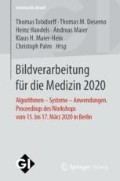Zusammenfassung
Fundus photography and Optical Coherence Tomography Angiography (OCT-A) are two commonly used modalities in ophthalmic imaging. With the development of deep learning algorithms, fundus image processing, especially retinal vessel segmentation, has been extensively studied. Built upon the known operator theory, interpretable deep network pipelines with well-defined modules have been constructed on fundus images. In this work, we firstly train a modularized network pipeline for the task of retinal vessel segmentation on the fundus database DRIVE. The pretrained preprocessing module from the pipeline is then directly transferred onto OCT-A data for image quality enhancement without further fine-tuning. Output images show that the preprocessing net can balance the contrast, suppress noise and thereby produce vessel trees with improved connectivity in both image modalities. The visual impression is confirmed by an observer study with five OCT-A experts. Statistics of the grades by the experts indicate that the transferred module improves both the image quality and the diagnostic quality. Our work provides an example that modules within network pipelines that are built upon the known operator theory facilitate cross-modality reuse without additional training or transfer learning.
Access this chapter
Tax calculation will be finalised at checkout
Purchases are for personal use only
Preview
Unable to display preview. Download preview PDF.
Literatur
Srinidhi CL, Aparna P, Rajan J. Recent advancements in retinal vessel segmentation. J med Syst. 2017;41(4):70.
Husvogt L, Ploner S, Maier A. Optical coherence tomography. Springer, Cham; 2018. p. 251–261.
Choi W, Moult EM, Waheed NK, et al. Ultrahigh-Speed, swept-source optical coherence tomography angiography in nonexudative age-related macular degeneration with geographic atrophy. Ophthalmology. 2015;.
Maier AK, Syben C, Stimpel B, et al. Learning with known operators reduces maximum error bounds. Nature machine intelligence. 2019;1(8):373–380.
Fu W, Breininger K, Schaffert R, et al. A divide-and-conquer approach towards understanding deep networks. In: MICCAI. Springer; 2019. p. 183–191.
Lin TY, Goyal P, Girshick R, et al. Focal loss for dense object detection. In: Proceedings of the IEEE international conference on computer vision; 2017. p. 2980–2988.
Kingma DP, Ba J. Adam: a method for stochastic optimization. arXiv preprint arXiv:14126980. 2014;.
Zuiderveld K. Contrast limited adaptive histogram equalization. In: Graphics gems IV. Academic Press Professional, Inc.; 1994. p. 474–485.
Husvogt L, Ploner S, Moult EM, et al. Using medical image reconstruction methods for denoising of OCTA data. Invest Ophthal Vis Sci. 2019;60:3096.
Author information
Authors and Affiliations
Corresponding author
Editor information
Editors and Affiliations
Rights and permissions
Copyright information
© 2020 Springer Fachmedien Wiesbaden GmbH, ein Teil von Springer Nature
About this paper
Cite this paper
Fu, W., Husvogt, L., Ploner, S., Fujimoto, J.G., Maier, A. (2020). Modularization of Deep Networks Allows Cross-Modality Reuse. In: Tolxdorff, T., Deserno, T., Handels, H., Maier, A., Maier-Hein, K., Palm, C. (eds) Bildverarbeitung für die Medizin 2020. Informatik aktuell. Springer Vieweg, Wiesbaden. https://doi.org/10.1007/978-3-658-29267-6_61
Download citation
DOI: https://doi.org/10.1007/978-3-658-29267-6_61
Published:
Publisher Name: Springer Vieweg, Wiesbaden
Print ISBN: 978-3-658-29266-9
Online ISBN: 978-3-658-29267-6
eBook Packages: Computer Science and Engineering (German Language)

